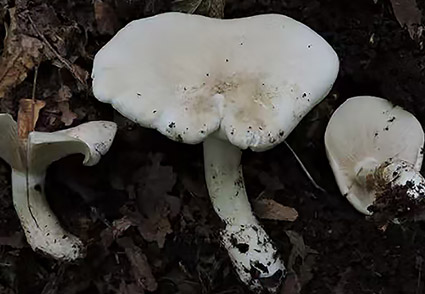Abstract
A new species, Harmajaea xizangense, discovered in Tibet, China, is illustrated and described based on morphological and molecular data. Morphologically, H. xizangense is mainly characterized by its small pileus, relatively larger and longer spores, and unique geographical distribution. Phylogenetic analyses were performed based on nucleotide sequences of four molecular loci: the internal transcribed spacer (ITS), the nuclear ribosomal large subunit (nrLSU), the DNA-directed RNA polymerase II subunit 2 (RPB2), and the translation elongation factor (TEF1-α). The results indicated that the specimens belonged to the genus Harmajaea, occupying an isolated position in the phylogenetic trees. Furthermore, three collections of H. harperi are introduced for the first time from Liaoning Province of China. This study provides full descriptions, color illustrations, and phylogenetic trees of the two Harmajaea species.
References
- Alvarado, P., Moreau, P.A., Sesli, E., Khodja, L.Y., Contu, M. & Vizzini, A. (2018a) Phylogenetic studies on Bonomyces (Tricholomatineae, Agaricales) and two new combinations from Clitocybe. Cryptogamie Mycologie 39 (2): 149–168. https://doi.org/10.7872/crym/v39.iss2.2018.149
- Alvarado, P., Moreau, P.A., Dima, B., Vizzini, A., Consiglio, G., Moreno, G., Setti, L., Kekki, T., Huhtinen, S., Liimatainen, K. & Niskanen, T. (2018b) Pseudoclitocybaceae fam. nov. (Agaricales, Tricholomatineae), a new arrangement at family, genus and species level. Fungal diversity 90 (1): 109–133. https://doi.org/10.1007/s13225-018-0400-1
- Don, R.H., Cox, P.T., Wainwright, B.J., Baker, K. & Mattick, J.S. (1991) Touchdown PCR to circumvent spurious priming during gene amplification. Nucleic Acids Research 19 (14): 4008. http://dx.doi.org/10.1093/nar/19.14.4008
- Hall, T.A. (1999) BioEdit: a user-friendly biological sequence alignment editor and analysis program for Windows 95/98/NT. Nucleic Acids Symposium Series 41: 95–98.
- Harmaja, H. (1969) The genus Clitocybe (Agaricales) in Fennoscandia. Karstenia 10: 5–121. https://doi.org/10.29203/ka.1969.62
- Harmaja, H. (1978) New species and combinations in the pale-spored Agaricales. Karstenia 18: 29–30. https://doi.org/10.29203/ka.1978.134
- Harmaja, H. (1979) Type studies in Clitocybe 3. Karstenia 19: 22–24. https://doi.org/10.29203/ka.1979.181
- He, Z.M. & Yang, Z.L. (2022) The genera Bonomyces, Harmajaea and Notholepista from Northwestern China: two new species and a new record. Mycological Progress 21 (2): 26. https://doi.org/10.1007/s11557-022-01786-0
- Kalyaanamoorthy, S., Minh, B.Q., Wong, T.K.F, Haeseler, A.V. & Jermiin, L.S. (2017) ModelFinder: fast model selection for accurate phylogenetic estimates. Nature Methods 14: 587–589. https://doi.org/10.1038/nmeth.4285
- Katoh, K. & Standley, D.M. (2013) MAFFT multiple sequence alignment software version 7: improvements in performance and usability. Molecular Biology and Evolution 30: 772–780. https://doi.org/10.1093/molbev/mst010
- Kornerup, A. & Wanscher, J.H.K. (1978) The Methuen Handbook of Colour. Eyre Methuen, London.
- Lanfear, R., Frandsen, P.B., Wright, A.M., Senfeld, T. & Calcott, B. (2017) PartitionFinder 2: new methods for selecting partitioned models of evolution formolecular and morphological phylogenetic analyses. Molecular Biology and Evolution 34 (3): 772–773. https://doi.org/10.1093/molbev/msw260
- Matheny, P.B. (2005) Improving phylogenetic inference of mushrooms with RPB1 and RPB2 nucleotide sequences (Inocybe; Agaricales). Molecular phylogenetics and evolution 35 (1): 1–20. https://doi.org/10.1016/j.ympev.2004.11.014
- Matheny, P.B., Wang, Z., Binder, M., Curtis, J.M., Lim, Y.W., Nilsson, H., Hughes, K.W., Hofstetter, V., Ammirati, J.F., Schoch, C.L., Langer, E., Langer, G., McLaughlin, D.J., Wilson, A.W., Frøslev, T., Ge, Z.W., Kerrigan, R.W., Slot, J.C., Yang, Z.L., Baroni, T.J., Fischer, M., Hosaka, K., Matsuura, K., Seidl, M.T., Vauras, J. & Hibbett, D.S. (2007) Contributions of rpb2 and tef1 to the phylogeny of mushrooms and allies (Basidiomycota, Fungi). Molecular phylogenetics and evolution 43 (2): 430–451. https://doi.org/10.1016/j.ympev.2006.08.024
- Murrill, W.A. (1913) The Agaricaceae of the Pacific Coast—IV. New species of Clitocybe and Melanoleuca. Mycologia 5: 206–223. https://doi.org/10.1080/00275361913.12018520
- Rambaut, A. (2018) FigTree v1.4.4: Tree Figure Drawing Tool. Available from: https://github.com/rambaut/figtree/releases (accessed 18 September 2024)
- Rehner, S.A. & Buckley, E. (2005) A Beauveria phylogeny inferred from nuclear ITS and EF1-a sequences: evidence for cryptic diversification and links to Cordyceps teleomorphs. Mycologia 97 (1): 84–98. http://dx.doi.org/10.1080/15572536.2006.11832842
- Ronquist, F., Teslenko, M., van der Mark, P., Ayres, D.L., Darling, A., Höhna, S., Larget, B., Liu, L., Suchard, M.A. & Huelsenbeck, J.P. (2012) MrBayes 3.2: efficient Bayesian phylogenetic inference and model choice across a large model space. Systematic Biology 61: 539–542. https://doi.org/10.1093/sysbio/sys029
- Stamatakis, A. (2014) RAxML version 8: a tool for phylogenetic analysis and post-analysis of large phylogenies. Bioinformatics (Oxford, England) 30 (9): 1312–1313. https://doi.org/10.1093/bioinformatics/btu033
- Vilgalys, R. & Hestsr, M. (1990) Rapid genetic identification and mapping of enzymatically amplified ribosomal DNA from several cryptococcus species. Journal of bacteriology 172 (8): 4238–4246 https://doi.org/10.1128/jb.172.8.4238-4246.1990
- Vizzini, A., Ercole, E. & Contu, M. (2012) A contribution to the ITS-LSU phylogeny of the genus Leucopaxillus (tricholomatoid clade, Agaricales), with three new genera and notes on Porpoloma. Mycosphere 3: 79–90. https://doi.org/10.5943/mycosphere/3/1/10.
- White, T.J., Bruns, T., Lee, S. & Taylor, J.W. (1990) Amplification and direct sequencing of fungal ribosomal RNA genes for phylogenetics. In: Innis, M.A., Gelfand, D.H., Sninsky, J.J. & White, T.J. (Eds.) PCR protocols: a guide to methods and applications. Academic Press Inc., New York, pp. 315–322. https://doi.org/10.1016./B978-0-12-372180-8.50042-1


